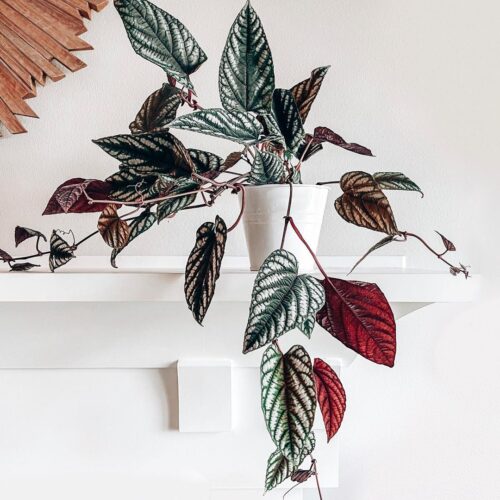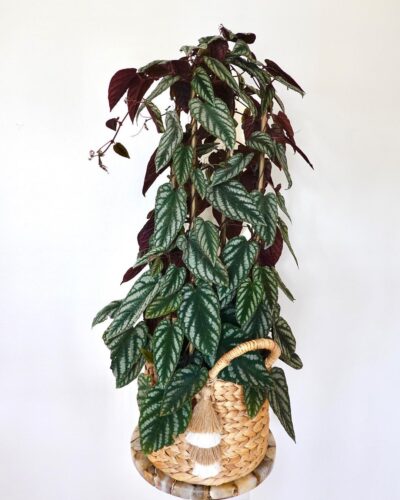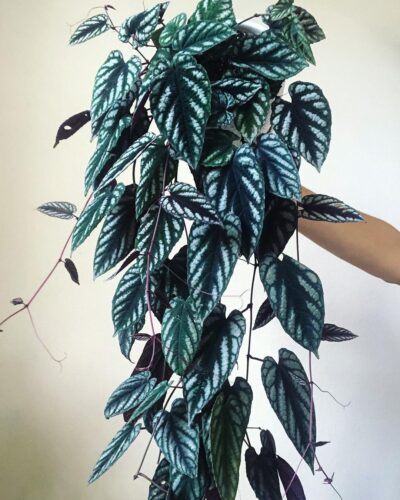Read in detail about Rex Begonia Vine growing and care information in this guide and grow this beautiful plant in your home.
Grow rex begonia vine in hanging baskets or decorative pots around fences or trellises. This perennial vine climbs and trails beautifully for years if not exposed to cold temperatures. Read more Cissus Discolor care details in this guide.
Read: Gryphon Begonia Growing and Care Information
Rex Begonia Information

Also known as tapestry vine, Rex Begonia (Cissus Discolor) is not related to true rex begonias. It displays multicolored leaves that resemble rex begonia, hence the common name derived.
This vine comes from Southeast Asia, comprising Cambodia and Java. It is closely linked to a grape plant than begonia. As a vine, it can grow up to 8-10 inches long with colorful heart-shaped, elongated leaves. Young leaves emerge in a dark burgundy shade and mature in a deep green color with silver-white patterns between leaf veins on thin, wiry stems. The outer edges, center, and undersides of the foliage are burgundy-wine.
Read: Alocasia Wentii Care
How to Propagate Rex Begonia
- You can propagate rex begonia from cuttings.
- Cut a 6-8 inches long stem cutting from a healthy plant in early spring or late fall.
- Remove the leaves from the bottom, and dip the cut ends in the rooting hormone.
- Plant the cutting in a pot filled with well-draining soil.
- Water thoroughly, cover the pot with a plastic bag, and punch some holes in it for air circulation.
- Keep the pot in an area with bright, indirect light.
- The cutting will root in up to 30-40 days.
Read: Monstera Lechleriana Care
Ideal Growing Conditions for Rex Begonia Vine

Light
This vine requires bright indirect light for fine growth. To boost colorful foliage, place the plant near an east-facing window; it will provide mild morning sun and protect the leaves from harsh afternoon light.
Soil
Cissus Discolor plants prefer nutrient-rich, well-draining soil. You can prepare it on your own by mixing 50 percent regular potting mix with 40 percent perlite and 10 percent peat moss for better drainage and nutrients.
Water
Water Cissus discolor regularly across the growing season (spring and summer). Do not let the soil dry out entirely. Before watering, check the moisture of the soil with your fingers; if it feels dry to the touch, then it’s time to water the plant.
If you notice droopy leaves, then it indicates overwatering; in such case, do not water the plant till the topsoil turns dry.
Temperature and Humidity
This vine does well in warm temperatures. In summer months, rex begonia vine performs well in the temperature range between 70-80 F (21-27 C). Whereas, in cold months, maintain it between a range of 65-70 F (18-21 C).
It appreciates high humidity; to improve humid conditions, use a humidifier or put the plant on a tray with pebbles and water. You can also group plants together to boost humidity.
Read: Costus Barbatus Care
Rex Begonia Vine Care

Fertilizer
Feed your begonia with a balanced liquid fertilizer in summer and spring once every 5-7 weeks. Follow the instructions on the package, and do not fertilize the plant in winter.
Pruning
This begonia does not need pruning, though a bit of trimming every 2-3 months can keep the look tidy. As this vine is grown in hanging baskets or trellis, light pruning gives it a bushier look.
Pests and Diseases
Cissus discolor can be attacked by whiteflies; treat them by using a cotton ball dipped in alcohol. If you notice scalding or brown spots, this indicates burns caused by bright, direct sun. To prevent this, keep the plant in an area with diffused light.



